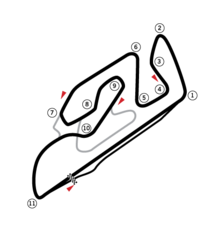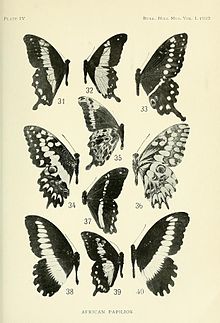올리브 벌집
Olive bee-eater| 올리브 벌집 | |
|---|---|
 | |
| 과학적 분류 | |
| 킹덤: | 애니멀리아 |
| 망울: | 코다타 |
| 클래스: | 아베스 |
| 순서: | 코라시목 |
| 패밀리: | 메로피과 |
| 속: | 메롭스 |
| 종: | M. 슈퍼실리오스 |
| 이항식 이름 | |
| 메롭스 슈퍼실리오스 | |
올리브 벌집 또는 마다가스카르 벌집(Merops superciliosus)은 메롭스 속(Merops superciliosus)에서 거의 지나가는 벌집 종이다.It is native to the southern half of Africa where it is present in Angola; Botswana; Burundi; Comoros; Democratic Republic of the Congo; Djibouti; Eritrea; Ethiopia; Kenya; Madagascar; Malawi; Mayotte; Mozambique; Namibia; Rwanda; Somalia; South Sudan; Sudan; Tanzania; Uganda; Zambia; Zimbabwe.범위가 넓은 일반종이라 국제자연보전연맹은 이들의 보존 상태를 '최저 관심사'로 평가했다.[1]
분류학
1760년 프랑스의 동물학자 마투린 자크 브리송은 마다가스카르 섬에서 채취한 표본을 바탕으로 그의 오르니톨로지에 올리브 벌에 대한 설명을 포함시켰다.그는 프랑스 이름인 Lemanimpier de Madagascariensis와 라틴어 Apiaster Madagascariensis를 사용했다.[2]비록 브리슨이 라틴어 이름을 만들었지만, 이것들은 이항체계에 부합하지 않고 국제 동물학 명칭 위원회에서는 인정하지 않는다.[3]1766년 스웨덴의 자연주의자 칼 린네우스가 12번째 판을 위해 자신의 Systema Naturae를 업데이트했을 때, 그는 이전에 브리송에 의해 기술된 240종을 추가했다.[3]이것들 중 하나는 올리브 벌집이었다.리나에우스는 간략한 설명을 포함시켜 현재의 이항명인 메롭스 슈퍼실리오스를 만들고 브리송의 작품을 인용했다.[4]특정 이름인 슈퍼실리오스는 라틴어로 "수상한", "하키티" 또는 "눈이 부시게"를 의미한다.[5]
- M. S. 슈퍼실리오스 리네우스, 1766년 – 동아프리카, 마다가스카르 및 코모로 제도
- M. s. 교대형 클랜시, 1971 – 서 앙골라 및 북서 나미비아
설명
올리브 벌집털은 꼬리줄기가 최대 7cm(2.8인치)까지 늘어나면서 23~26cm(9.1~10.2인치)까지 자란다.성별은 비슷하며, 성인은 올리브모자와 하얀 이마, 눈썹, 턱, 볼이 있는 엷은 녹색 매실을 가지고 있다.줄기와 꼬리는 검은 줄기와는 별도로 파랗다.[7]
분배
올리브 벌집은 동아프리카와 마다가스카르의 초원과 해안산림에서 발견되며, 앙골라 해안에서는 고립된 개체군을 발견할 수 있다.[8]M. s. s. s. s. s. s. s. s. s. s. s. s. s. s. s.는 에티오피아 동부, 소말리아, 케냐 남부, 동아프리카를 거쳐 코모잠비크 남부와 잠베지 계곡, 그리고 코모로 제도와 마다가스카르까지 발생하며, M. s. 교대는 앙골라 서부와 나미비아 북서부에서 발생한다.[9]
생태학
그들은 부분적으로 철새고, 보통 사역의 남쪽 지역에서만 번식하며, 남부 아프리카의 건기 동안 북쪽으로 이동한다.남아프리카 우기가 시작될 때 굴 둥지에 4개의 알을 낳고, 병아리들은 보통 12월 초에 부화한다.[10]대부분의 벌떼와 달리 이 종은 협동 번식을 실천하지 않고, 번식 후의 의존도는 19일 정도에 불과하며, 이는 온대 행인의 전형이며, 대부분의 메로피대 종의 절반 정도에 해당한다.[11]
갤러리
참조
- ^ a b BirdLife International (2016). "Merops superciliosus". IUCN Red List of Threatened Species. 2016: e.T22683744A92998077. doi:10.2305/IUCN.UK.2016-3.RLTS.T22683744A92998077.en. Retrieved 12 November 2021.
- ^ Brisson, Mathurin 자크(1760년).Ornithologie, 해석, 메토드contenant 라 사단 데 oiseaux especes & 앙 ordres 섹션, 장르,;leurs variétés(중에 프랑스와 라틴어).Vol4. 파리:장 바티스트 Bauche.를 대신하여 서명함. 545–549, 판 42무화과 1.이 두 스타는(**)구간의 시작에서 Brisson 시편의 시험에서 그의 설명 근거를 나타낸다.
- ^ a b Allen, J.A. (1910). "Collation of Brisson's genera of birds with those of Linnaeus". Bulletin of the American Museum of Natural History. 28: 317–335. hdl:2246/678.
- ^ Linnaeus, Carl (1766). Systema naturae : per regna tria natura, secundum classes, ordines, genera, species, cum characteribus, differentiis, synonymis, locis (in Latin). Vol. 1, Part 1 (12th ed.). Holmiae (Stockholm): Laurentii Salvii. p. 183.
- ^ Jobling, J.A. (2018). del Hoyo, J.; Elliott, A.; Sargatal, J.; Christie, D.A.; de Juana, E. (eds.). "Key to Scientific Names in Ornithology". Handbook of the Birds of the World Alive. Lynx Edicions. Retrieved 6 July 2018.
- ^ Gill, Frank; Donsker, David, eds. (2018). "Todies, motmots, bee-eaters, hoopoes, wood hoopoes, hornbills". World Bird List Version 8.2. International Ornithologists' Union. Retrieved 6 July 2018.
- ^ Fry, C. Hilary; Fry, Kathie (2010). Kingfishers, Bee-eaters and Rollers. Bloomsbury Publishing. p. 273. ISBN 978-1-4081-3525-9.
- ^ "Range map". IUCN. Retrieved 16 October 2016.
- ^ Fry, H.; Boesman, P. (2016). "Olive Bee-eater (Merops superciliosus)". Handbook of the Birds of the World Alive. Lynx Edicions, Barcelona. Retrieved 16 October 2016.
- ^ "Madagascar Bee-eater, Olive Bee-eater". Biodiversity Explorer. Iziko. Retrieved 16 October 2016.
- ^ Langen, Tom A. (2000). "Prolonged offspring dependence and cooperative breeding in birds". Behavioral Ecology. 11 (4): 367–377. doi:10.1093/beheco/11.4.367.
외부 링크
- 올리브 벌집 - 남아프리카 새의 아틀라스에 있는 종 문자.






